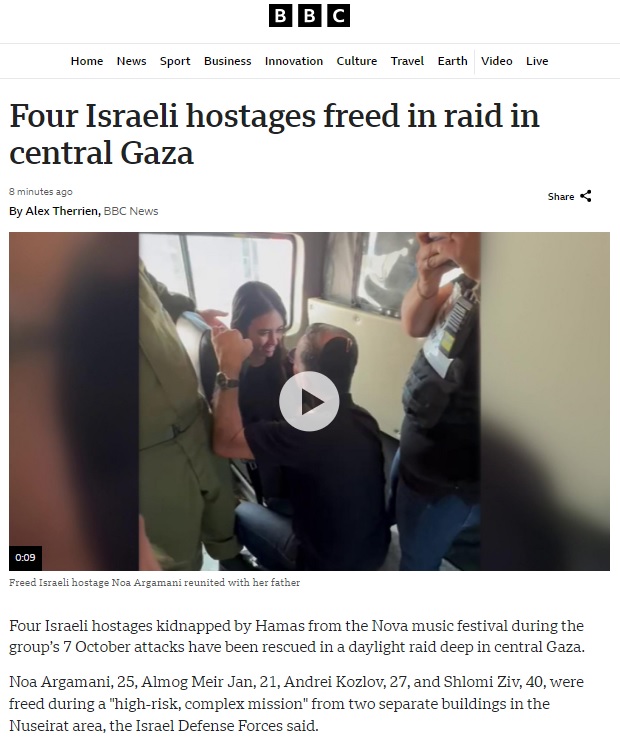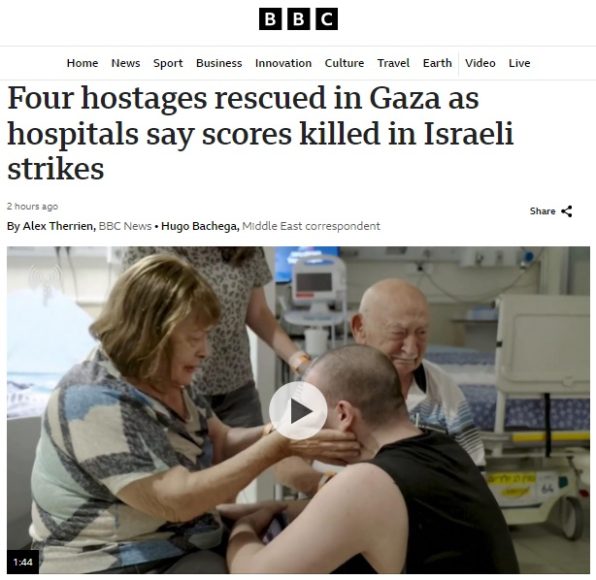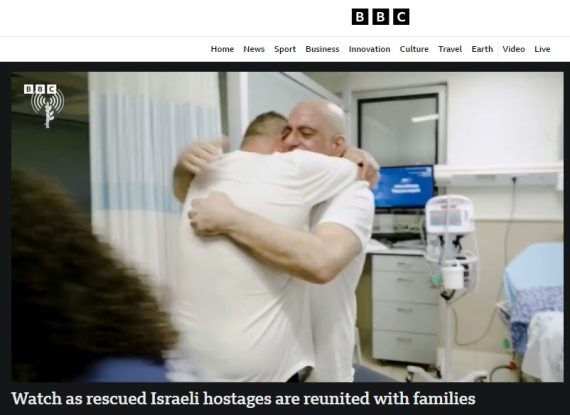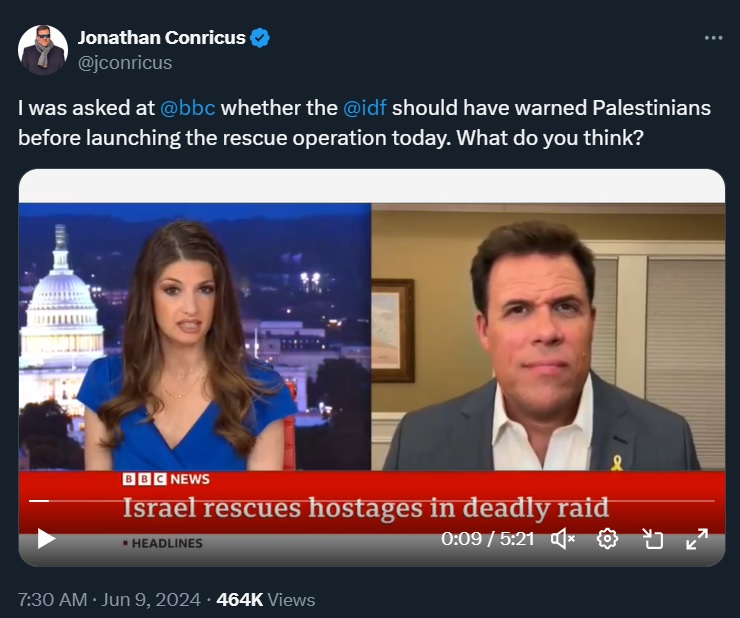Omission and inaccuracy in BBC reporting on Israeli hostage rescue

On the afternoon of June 8th, not long after news had broken of the rescue of four Israeli hostages from the Gaza Strip, the BBC News website published a report on its ‘Middle East’ page.

Following later amendments, that report currently goes under the headline “Four hostages rescued in Gaza as hospitals say scores killed in Israeli strikes” and is now credited to Alex Therrien and Hugo Bachega.

The report tells BBC audiences that: [emphasis added]
“Miss Argamani, a Chinese-born Israeli citizen, was kidnapped from the Nova festival and harrowing video footage from 7 October showed the 26-year-old being taken away on the back of a motorbike screaming, “Don’t kill me!” […]
Mr Kozlov, a Russian who moved to Israel in 2022, and Mr Ziv had both been working as security guards at the festival when they were kidnapped.”
As her mother clarified last October, Noa Argamani was not born in China but in Israel. Andrey Kozlov is a dual citizen of both Israel and Russia. CAMERA UK has submitted a request for corrections on those points to the BBC.
Additional BBC content relating to the same story includes:
“Watch as rescued Israeli hostages are reunited with families” filmed, uncredited
“How Israel’s hostage rescue in Gaza unfolded” by Jon Donnison, 9/6/24

The geographical location of the rescue operation is presented in the synopsis of the filmed report as “central Gaza”. In Therrien and Bachega’s report, readers are initially told that the operation took place “in the Nuseirat area” and in paragraph 24 that:
“While there was jubilation in Israel, images and video showed death, injury and destruction in the area, including around the al-Nuseirat refugee camp.
According to BBC Verify, it appeared that Israeli strikes took place across several locations in central Gaza, but Nuseirat – the location of the IDF operation to release four hostages – seems to have been hit hardest.”
In Donnison’s report, the operation is described as having taken place in “central Gaza”, in “the densely populated Nuseirat camp”.
None of those three BBC reports clarifies that the Nuseirat refugee camp is run by UNRWA and includes schools, health centres, social services offices and additional installations. In addition to failing to clarify that the hostages were held for eight months in an area administered by that UN organisation, two of the three reports are equally unhelpful on the topic of the status of the buildings in which the hostages were incarcerated.
The synopsis of the filmed report refers to “two separate buildings”, as does Therrien and Bachega’s report:
“IDF spokesman Daniel Hagari said the mission was based on “precise” intelligence and the hostages were freed from two separate buildings in Nuseirat.”
Only in Donnison’s report do readers find a brief reference to the fact that the four hostages had been held captive for eight months in the homes of civilians. [emphasis added]
“Acting on intelligence, and after crossing into Gaza from Israel, he [IDF spokesman] said specialist commandos simultaneously raided two residential apartments in Nuseirat where the hostages were being held.
In one apartment was 26-year-old hostage Noa Argamani. In the other were 41-year-old Shlomi Ziv, 27-year-old Andrey Kozlov and Almog Meir Jan, 22.
Mr Hagari said they were not in cages but in locked rooms surrounded by guards.”
Those omissions are of course highly relevant in light of the BBC’s concurrent promotion of unverified claims concerning civilian casualties during the rescue operation. The synopsis of the filmed report tells BBC audiences that:
“Many Palestinians, including children, were killed and injured in the area where the operation took place, with images and footage showing a large numbers [sic] of casualties.
Two hospitals in Gaza, al-Aqsa hospital and al-Awda hospital, said they have counted 70 bodies between them, while Hamas’s media office put the death toll at more than 200.”
That report fails to clarify that Hamas deliberately does not distinguish between civilian and combatant casualties and viewers are told nothing of the heavy exchanges of fire between the rescuers and terrorists armed with RPGs, machine guns and anti-aircraft missiles.
In Therrien and Bachega’s report – the headline of which refers to “scores killed in Israeli strikes” – readers are told of “a raid that Palestinian officials say killed scores of people” before the article goes on:
“Israeli forces, backed by air strikes, fought intense gun battles with Hamas in the Nuseirat area, in what the Israel Defense Forces called a “high-risk, complex mission”.
Palestinian officials say women and children were among those killed in the military assault.
Two hospitals in Gaza, al-Aqsa hospital and al-Awda hospital, said they had counted 70 bodies between them, while Hamas’s government media office said at least 210 people had been killed in Israeli strikes in and around the al-Nuseirat refugee camp.
Israel estimated there were fewer than 100 casualties, IDF spokesman Daniel Hagari said.”
The possibility that some of the Palestinian casualties may have been caused by heavily armed terrorists trying to prevent the rescue of hostages from a residential area – and that some of the casualties may be Hamas terrorists rather than civilians – is not raised at all by Therrien and Bachega, who also ignore the issue of Hamas’ use of civilians as human shields by holding hostages in residential buildings.
Donnison’s report tells readers that:
“For Israelis, it brought celebration and relief. For Palestinians, it brought more suffering, with hospitals saying dozens of people – including children – were killed in the raid on the densely populated Nuseirat camp. […]
As they [the Israeli forces] left he [the IDF spokesman] said they faced fierce resistance from Palestinian fighters. […]
Mobile phone video from the scene shows people diving for cover as missiles whistled in and gunfire rang out.
Later footage showed bodies strewn in the street.
The raid clearly involved massive force. Doctors at the two hospital [sic] in central Gaza said they had counted more than 70 bodies.
Mr Hagari estimated less than a hundred, while the Hamas media office said more than 200 had been killed.
The BBC has been unable to verify the number of casualties.”
Although Donnison has no qualms about going on to promote a vox pop claim of “genocide”, he too fails to adequately discuss the issue of hostages being held in a residential area for months on end (clearly with the knowledge of some civilians), Hamas attacking rescue teams with weapons including RPGs and the possibility that some civilian casualties may be the result of those Hamas decisions and actions.
Had such issues been clarified in its reporting, the BBC could perhaps have avoided embarrassing itself with a ridiculous question later posed by its presenter Helena Humphrey – a former UN and Red Cross employee.

As has all too often been the case since October 7th, in the rush to report dramatic stories about Palestinian casualties, the BBC’s journalists are only too willing to promote unconfirmed numbers sourced from the very terrorist organisation which started the war (and has been illegally holding hostages for eight months) and to skip over relevant parts of the story. Sadly for the BBC’s funding public, such irresponsible and agenda-driven reporting no longer comes as a surprise.
This article originally appeared here and is reposted with permission.

Hadar Sela was born in the north of England and has lived in Israel for over three decades. She has a special interest in the influence of the media on the British public’s perceptions of the Middle East and the Islamist networks operating in the UK and has written pre-emptive reports on several anti-Israel campaigns, including the flotillas and the Global March to Jerusalem in March 2012. Hadar’s work has been published in the Jerusalem Post, The Algemeiner, The Commentator, MERIA Journal and at Harry’s Place, among others.













